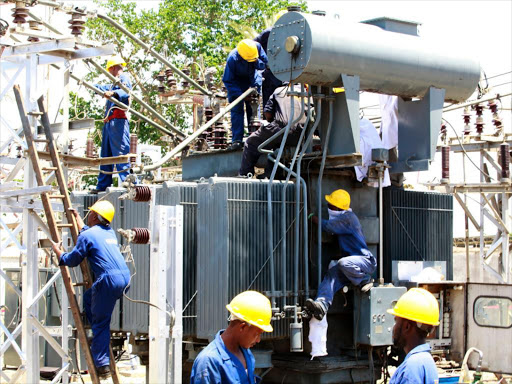•Net profit for the year ended June 30, 2019 dropped to Sh262 million from Sh3.3 billion the previous year.
•It has warned earnings are likely to further dip this year on effects of Covid-19 on its business. Kenya Power engineers carry out maintenance work at a power Sub station in Mombasa. /FILE An increase in non-fuel power purchase costs was one of the main reasons for Kenya Power’s 91.9 per cent drop in profit, the utility firm has told investors.
The costs went up by Sh18.1 billion to Sh70.9 billion, from Sh52.8 billion in a similar period in 2018, it said in its audited financial results for the year ended June 30, 2019.
This was propelled by the commissioning of two power plants with a combined generation capacity of 360MW.
“In addition, finance costs rose by Sh3.2 billion due to increased levels of short-term borrowing and foreign exchange losses,” company secretary Imelda Bore notes in audited financial results unveiled by the Nairobi Securities Exchange on Monday.
In the year under review, the utility firm’s net profit dropped to Sh262 million from Sh3.3 billion the previous year, which it had reported in its unaudited results earlier this year.
The costly purchases eroded gains made on revenues from electricity sales which grew by Sh16.9 billion to close at Sh112.4 billion, from Sh95.4 billion the previous year, a 17.8 per cent increase.
The rise in revenue is partly attributed to a tariff review at the beginning of the year prior to the subsequent tariff harmonisation that lowered rates for small commercial customers and broadened life-line tariff for domestic customers.
“The growth in revenue was also supported by a 3.4 per cent increase in unit sales from 7,905 GWh to 8,174 GWh owing to an expanding customer base,” the company notes.
During the period, fuel costs decreased by Sh5.2 billion or 22.5 per cent from Sh23.5 billion in 2018, to Sh18.2 billion , due to improved energy mix following less utilisation of expensive thermal plants.
Units generated from thermal plants decreased by 904 GWh from 2,202 GWh the previous year , to 1,298 GWh, it notes.Transmission and distribution costs equally decreased from Sh44.5 billion incurred in 2018, to Sh41 billion.“The reduction of Sh3.4 billion was mainly due to lower provisions for trade and other receivables during the year compared to the previous year,” the company says.Meanwhile, it has warned of a further drop in profit in the year ending June 2019.According to the […]
